Baptism records can be treasure troves of information when searching for your ancestors. Before the 1870s, it was churches, not civil authorities, who were responsible for keeping track of the major life events of their members, which means that these records are very helpful for genealogists. So what can you find in these fascinating documents?
*For more detailed help with these documents, as well as a step by step guide to deciphering baptismal paragraph records, marriage records, and death records, check out The Magic of German Church Records Book.
Baptismal Records Include:
- Name of child
- Place of birth
- Religion
- Dates of birth and baptism
- Legitimacy of the child
- Parents’ names (often mother’s maiden name as well) and occupations
- Godparents’ names and occupations
- Pastor’s Name
- Midwife’s name
“Wonderful!” you say. “I’d like to know all these things.” Only one problem – the records are in German, and, to make matters worse, written in the rather tricky German handwriting. However, you don’t need to be a handwriting expert to get the information you need out of these records. Why not? Just being able to pick out the main words can give you a significant start in finding the information you are looking for.
Important Baptismal Record Vocabulary:
What Those Column Headings Mean:
Next, it helps to be familiar with the column headings on these records. When deciphering the handwriting, it is extremely important to have an idea of what kind of words you could be looking at. Therefore, if you know what the columns mean, deciphering the words in that column will be a great deal easier. Most church record columns look something like this, although it will vary slightly from parish to parish:
English:
The transcription and translation of the above column headings (as this was not the translation of this exact example, the dates do differ – 1883 vs 1888 – but the column headings are the same in both records)
But My Record Has Handwritten Column Headings!
For our practical purposes today, however, we are going to look at a more difficult record – with the columns handwritten instead of typed.
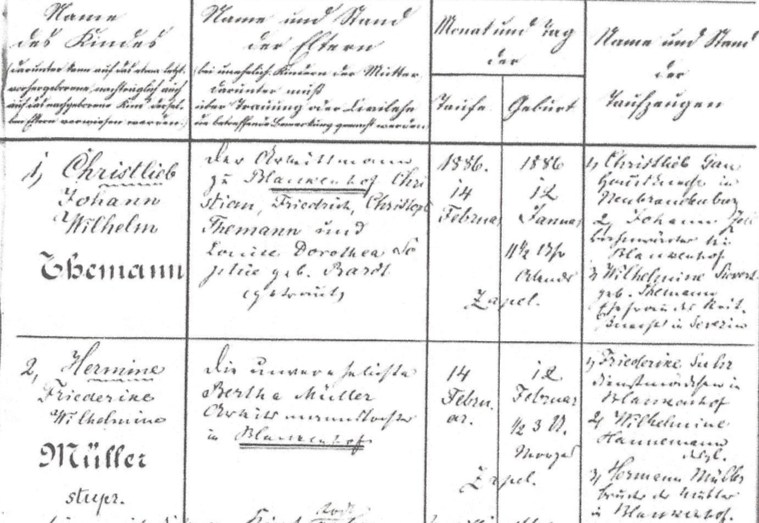 Baptismal Record of Hermine Friederike Wilhelmine Müller
Baptismal Record of Hermine Friederike Wilhelmine Müller
Let’s now examine this record more closely. While ideally you’d be able to read a bit of the handwriting yourself (check out the handwriting course if you’d like to learn!), let’s pretend that you can’t. In that case, where do we start? As I mentioned above, knowing what the columns mean helps us to decipher the information in that column much more easily. So let’s start with those column headings. Luckily, most baptismal records are set up in a somewhat similar fashion, with the column headings in a similar order.
The Process of Elimination
One column should be very simple. As you have found the record already, you likely know the child’s name. In this record, we therefore recognize our name “Hermine” as underlined in the first column. One column, check!
The third column has numbers, so what could that be? Dates! Those must be the dates of the birth and the baptism. Obviously, the date that is first chronologically must be the birth. Two columns, check!
That leaves us with two mystery columns remaining in this record. The final column, however, has three different names. As the parents’ column would have one or two names, this must be the column for the godparents/sponsors, of which there are normally between one and four people. The godparent column is also often one of the last columns, so this would make sense here as well. Three columns, check!
This leaves us with one important piece of missing information – the parents. The second column, therefore, must mention the parents’ names, which you can confirm by looking for the duplicate of the last name you are researching. So just by process of elimination, you have figured out all four of your headings. Check, check, check, check!
Below is the transcription and translation of the German column headings for Hermine’s record:


What if You Know A Bit of Handwriting?
Now let’s say you can read the handwriting a bit, but are overwhelmed by the large amount of information in those first two column headings. In this case, just look for the words you know. In the first column, for example, you may recognize “Namen” (name) and “Kind” (child). That is plenty of information to tell you what that column means – the rest is (usually) not too important, just extra information telling the scribe exactly what he should record. Don’t stress yourself out unnecessarily when you are only looking for names.

A close-up of Hermine’s record
Now that we know the column headings, it’s time to move on to the actual record. As we said, the first column in this record is the name. Many times, we luck out and the name is underlined. Here, the name is “Hermine Friederike Wilhelmine Müller”. Got it. But there is something else written there, some kind of abbreviation. What could that mean? After transcribing the letters, you see that it is “stupr.” To be honest, when I was transcribing this record, I was not sure myself what “stupr.” could mean. So what do I do when I don’t know an abbreviation? I go to my abbreviation finder website, abkuerzungen.de (abkürzungen = abbreviations). Alas, no luck! The website did not know this abbreviation.
Some Resource Help…
What next? I then go to my favorite German-English genealogical dictionary, which I highly recommend, and sure enough, I find the word “stuprat (Latin)” as meaning “pregnant before marriage”. This makes sense within the context of the record, but I still want to be sure. I now google “stuprata Latin genealogy” and sure enough, I find “stuprata” on Family Search’s Latin Genealogical Word List, meaning “pregnant out of wedlock.” Looks like we are good to go!
In the next column, we now know we are likely only looking for the mother, as this child was born out of wedlock (although in some cases, it may say “xxx acknowledges that he is the father…”). From the first column (and likely from our research), we can recognize the last name Müller. We now look directly before the last name to find the first name. Use your handwriting key to decipher the name, and you will see it is Bertha. We now have the name of the mother – Bertha Müller.
But where is she from? Usually, the name of the town will come after a preposition, such as “zu, in, aus, von” (in, in, from, from). In this column, we find the word “in”, and sure enough, the town is underlined right after it. If you are having trouble deciphering the town name, type your guess into Meyers Gazetteer, using asterisks for the letters you don’t recognize. Let’s say here you recognize the “Bl” at the beginning, and the “hof” at the end. Type “Bl*hof” into Meyer’s Gazetteer, and you will get a list of towns and cities with that letter combination. Compare the letters and location to your handwritten word, and see if any make sense. Here, I knew from my client that these records were from the Mecklenburg area. The first word on the list, Blankenhof, matched both the letters on the document and the area – that must be it!
We now have the child’s name and the name of the mother, as well as the town the mother is from. While we could keep deciphering the other information in the column, let’s say that’s all we want to know for now (see the full translation below if curious).
On to the third and fourth column – our dates. As we realized that the birth predates the baptism, the 14 before the 12 shows us that our first column here must be the baptism. Here, the month is rather easy to read – Februar, or February. If you can’t read the month, I’d recommend looking at the entries above and below yours. These entries are usually in chronological order, and perhaps a month before or after your entry is easier to read – that will at least narrow down what month you could be looking at, and thus help you to decipher your month a bit easier. The additional numbers are usually the time of birth. “Uhr” means “o’clock” in German, and here it is simply abbreviated with a “U.” This will usually be followed by the word “Morgens”/”Vormittags” (morning), “Nachmittags” (afternoon) or “Abends” (evening).
The “U” here stands for “Uhr” (o’clock).
Finally, in the last column we know we have the names of the witnesses. This is usually the most difficult column, as we don’t have much context to go off of to decipher these names. In many cases, the baptized child is named after one of the witnesses, so very often the first name of a witness is the same as the child itself. Here, we have two witnesses with the same names – Friederike and Wilhelmine. You will also recognize the same last name as the child in the third witness “Müller”. We look below his name, and it is often the case that there is an explanation for this relationship – sure enough, here it reads “Bruder der Mutter” (brother of the mother). A bonus relative – a reason that you should never ignore the witness column!
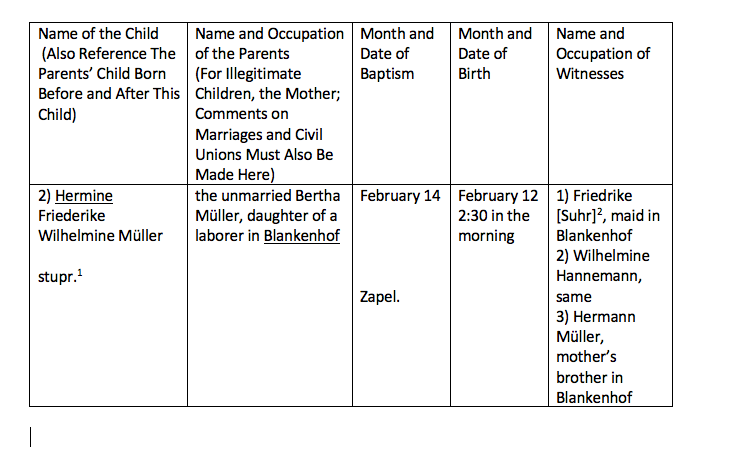 The full transcription and translation of the record
The full transcription and translation of the record
So there you have it! You now know the child’s name, the mother’s name, the town, dates of birth and baptism, and a bit of information about the witnesses. All the most important facts! Knowing what to look for is definitely key in deciphering these records. And now that you know, best of luck on your ancestor search!
*Enjoy this article? For more detailed help with these types of documents, as well as step by step guide to deciphering baptismal paragraph records, marriage records, and death records, check out The Magic of German Church Records Book.

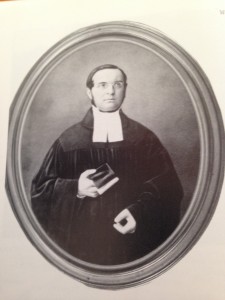



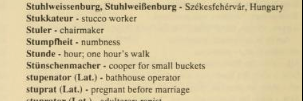
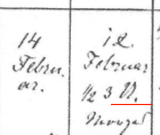
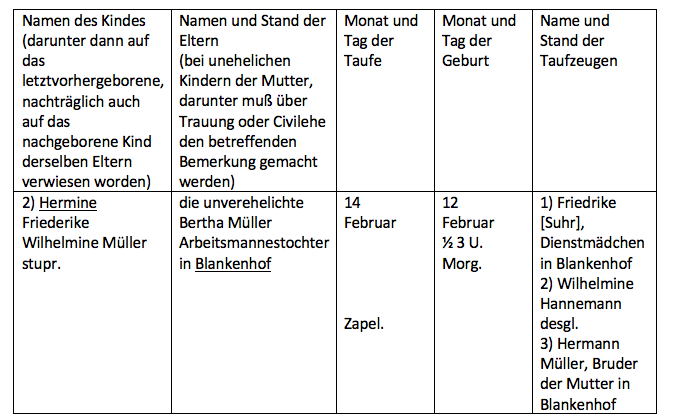
4 Responses
This is SO helpful!
What does obÿt mean in the following context:
In the column for the infant’s name…
Child’s name
obÿt [Handschrift symbol for den*] 16 Feb 1693
* a “d” with a long tail on it to the right
What character is the ÿ ? Could obÿt mean Latin “obit” (dies or died)?
The record for my ancestor, just below it, says “renata” instead of “obÿt” so the two records are different. (Renata is also Latin. meaning baptised. Does renata mean “reborn”—re + nata?)
I have my 4th great grandfather’s bible, listing the births of his four children. It was then given to his daughter and her husband, who added additional entries. I learned to read Handschrift while studying the hand-written entries for hours. Of course, I had a minor in German Literature, so I already knew (modern) German as a starting point. But Handschrift is completely different!
Hi Cindy – yes, likely “obit”, as in died. Renata literally means “reborn” to the best of my self-taught Latin knowledge, and does mean baptized in Latin. Sounds like you have a great headstart with the German!
Thank you.
Marilyn Hartley-Kik